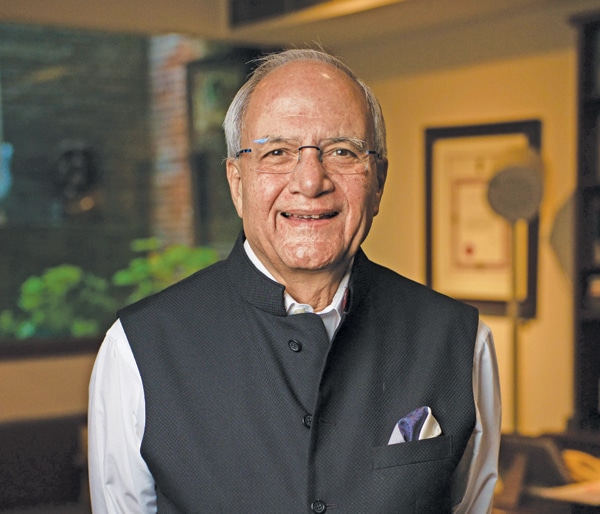EPIC Foundation aims to transform India into an electronics hardware product nation by collaborating with governments, universities, design houses, and startups. In a conversation with EFY’s Yashasvini Razdan, the Foundation’s Chairman and Former HCL Co-founder Ajai Chowdhry advocates for SME-friendly incentive schemes and stresses on developing a VC ecosystem for hardware.

Q. One of EPIC Foundation’s goals is “Transforming India into an electronics hardware product nation.” Aren’t we already well along that path, with the numerous policies that the government has introduced?
A. I have seen many Indian brands vanish despite favourable government policies for manufacturing. Now, that’s a very terrible situation to be in! At a time when the government has come up with great policies for manufacturing products in India, the question that remains is, how many Indian companies are benefiting from it? A few Indian companies, like Dixon and VVDN, manufacture for others, but a lack of Indian products globally is evident. This is not a good situation for a large country like India; we must have our own product ecosystem.
Q. So, how is EPIC Foundation working to build India’s product ecosystem, and who funds these activities?
A. EPIC advocates for building a product industry alongside semiconductor and component manufacturing as part of the India Semiconductor Mission Advisory Board. Manufacturing alone won’t suffice without solid product demand. Companies like Dixon are considering designing and manufacturing their products, but more must follow to compete globally. Our goal at EPIC is to collaborate with governments, fostering a comprehensive product ecosystem around universities, design houses, and startups. Over the next decade, this decentralised approach across the country can create a thriving design and product ecosystem, competing with China. By nurturing hundreds of brands, we can seize the opportunity created by the trust deficit with China, attracting countries to India for product design and manufacturing.
The initial funding was put in by my co-founder, Arjun Malhotra, and I. We do some consulting work to generate revenues and look at the industry to contribute through CSR (corporate social responsibility) activities.
A. How can India implement the ‘China plus one’ strategy?
A. When the concept of ‘China plus one’ emerged, Vietnam seized the opportunity quickly, leaving India behind. Rapid decision-making and ease of doing business contributed to Vietnam’s success, resulting in exports of $120 billion compared to India’s $25 billion. The challenge is to learn from the past and capitalise on ‘China plus two,’ where products with higher value addition become the focus. India is shifting from being a mere assembler to scaling up manufacturing, especially in areas like mobiles, where substantial exports are now a reality. Now, the focus needs to shift from low-value scale to sustained value addition to counter threats from competitors offering more incentives, potentially causing companies to move away. The key to navigating this landscape is understanding China’s shift to prioritise higher value addition while assigning manufacturing to countries like Vietnam.
Q. How does the contribution of MSMEs and startups in creating a high-value addition industry compare to that of large manufacturing companies?
A. When India signed the WTO agreement in 1999, applicable in 2015, MSMEs were adversely affected due to a lack of protection and zero-duty imports. Both startups and SMEs, essentially interchangeable, contribute significantly to the country’s design landscape and foster innovation. Unlike large corporations driven by quarterly results and stock market pressures, SMEs operate more flexibly, allowing for real innovation. Small companies can grow into large entities by securing substantial funds through IPOs and other public investment avenues, expanding manufacturing, and evolving into sizable companies.
Q. How can government incentive schemes be made more SME-inclusive?
A. Current policies lack focus on designing, creating, and adding value within India, hindering support for SMEs and startups. The emphasis is skewed toward large-scale manufacturing and favours global companies, necessitating a shift to SME-friendly policies. Schemes like SPECS fail to understand SMEs’ specific needs, with a significant difference in component revenue-to-investment ratio. Acknowledgement of this issue by the DPIIT Secretary is a positive step, and the awaited SPECS 2.0 is crucial for addressing SME concerns. A dedicated PLI for SMEs, promoting growth from ₹2 billion to ₹15 billion, can foster scale and inclusivity. Multiple SMEs producing both passive and active components are essential to strengthen the electronics industry. Long-term schemes, such as adopting a ten-year approach to develop the component industry beyond the typical three to five-year plans, are vital for sustained industry growth to make India a developed nation by 2047.
Q. Is EPIC’s role restricted to an advisor to the government, or is it acting as a mediator between SMEs, startups, and the state and central governments?
A. As an ecosystem player, we collaborate with the central government, state governments, research and education institutes, startups, and SMEs. We address challenges faced by SMEs in marketing by connecting them with established brands. Similarly, when startups or SMEs lack design expertise, we facilitate partnerships with education institutes possessing the required capabilities. This is an ongoing commitment, not a short-term endeavour, ensuring sustained support for the growth and development of these entities.
Q. The electronics industry encompasses different verticals. Do you believe that the current policies account for all these verticals?
A. In all sectors—electronics, telecom, and automobiles—components are crucial, with electric vehicles being 70% electronics, highlighting industry interconnectivity. Advising Niti Aayog, my focus was on identifying standard sub-assemblies and components across these sectors. Electronics should be viewed horizontally, given its influence across industries. Magazines like Electronics For You showcase this horizontal nature. Deeper exploration into service and component areas is crucial for enhanced value addition. Positive developments in the PLI for telecom, emphasising value addition and design, are steps in the right direction. Similar considerations should apply to hardware PLI, encouraging localisation and purchasing components in India for increased appeal. The current PLI framework requires re-evaluation for more effective implementation.
Q. How do we encourage more investments in equipment and infrastructure building to decrease the cost of production for SMEs and startups?
A. The VC ecosystem for hardware is non-existent, as most VCs prioritise e-commerce, software, and SaaS investments. With the evolving dynamics of the software industry, it’s crucial to plan for the next 15-20 years and steer India towards becoming a product-centric nation. Revisiting the proposed fund of funds, like the Electronics Development Fund, with a focus on hardware, is necessary. Allocating funds for startups and SMEs is essential, reconsidering the distinction between them for a more inclusive approach. Access to funds remains a significant hurdle; the fund of funds, initially proposed with ₹100 billion, should be revisited and possibly increased to ₹200 billion. A comprehensive approach, merging SMEs and startups, is essential for successful implementation, addressing the current funding challenge for these entities.
Q. Software Technology Parks of India (STPI) has established many Centres of Excellence for electronics innovation nationwide. Is such infrastructure not enough?
A. An initiative similar to STPI for hardware, akin to a Product Technology Park, can streamline processes, facilitate exports, and create a conducive environment for product development. This model would replicate the ease of doing business that STPI provides for the software industry. I envision the transformation of all 150 offices of STPI into HTPI (Hardware Technology Parks of India). These offices already possess the necessary infrastructure and space conducive to the skill development, design, and creation required for SMEs and startups. To foster hardware growth, we must replicate the same passion, incentives, and infrastructure models instrumental in developing the software industry.
Q. Should India set up a separate fund for research and development activities in SMEs and startups?
A. Once a fund of funds is established, investments can be made in various types of companies, whether design-oriented or manufacturing-focused. The current issue lies in the fact that VCs rarely invest in manufacturing. Addressing this through a comprehensive fund of funds, without limiting definitions to SMEs or startups, is crucial. The criterion for funding should revolve around entities involved in electronic product development, encompassing financing for research and development, design, and manufacturing.
Q. Is the cost of making a mistake while designing electronics hardware not much higher than the cost of making a mistake when developing software?
A. When designing a hardware product, a company will encounter mistakes during the initial attempts. With each iteration, the number of errors diminishes. The learning process is integral to organisational maturity, where processes evolve, mistakes decrease, and overall quality and reliability improve. This gradual progression requires acceptance, acknowledging that such refinement doesn’t occur overnight.
Q. Is that also the reason that hinders investors from venturing into the electronics sector?
A. Venture capitalists typically seek returns within the next five to ten years and desire an exit within five to seven years. However, achieving results in the electronics or design industry may take longer, necessitating patient capital. The US offers such patient capital, with numerous companies investing in extended product development and design projects. Unfortunately, such patient capital is absent in India, creating the need for a distinct policy tailored for startups and SMEs in the electronics sector.
Q. How can the Indian government incentivise investments in the local electronics industry?
A. Through demand aggregation, the government acts as a major buyer. This is similar to what the US did through significant investments in R&D centres like the Defence Advanced Research Projects Agency (DARPA), fostering innovation and industry growth. DARPA’s model involved presenting challenges to companies, providing funding for viable solutions, and subsequently awarding business opportunities to those who succeeded. In India, aligning central and state government policies is essential. States could be incentivised to prioritise locally made products by linking education fund allocations to purchasing domestically produced hardware, promoting the ‘Make in India’ initiative. This approach requires collaboration between the central and state governments to ensure a unified strategy for national development.
Q. If the government steps up and provides the funds, would we see more private investors venturing into this space?
A. When referring to a fund-of-funds, the government allocates a significant amount, say ₹100 billion, for software development. This sum is then divided among numerous venture capitalists (VCs). The crucial aspect is that each VC contributes additional funding, potentially amounting to ten times the initial allocation. Therefore, the impact of ₹100 billion does not merely double; it could multiply, reaching up to ₹1000 billion, exemplifying the leverage achieved through a fund-of-funds approach. The government can create a thriving electronics ecosystem by creating distinct funds tailored to specific sectors, such as the Electronics Development Fund or the Automotive Development Fund.






